Inexpensive E-Scooter
on
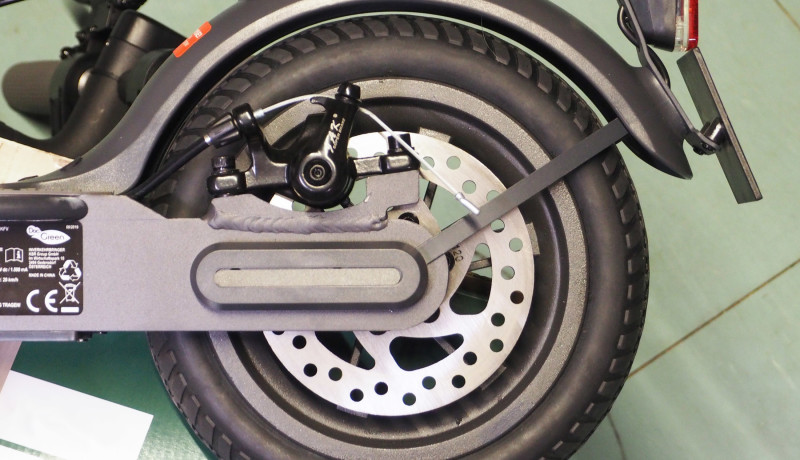
Last year I was on the road for the first time with a rental car in downtown Tel-Aviv. As such I am not squeamish and adapt to the regional driving habits quite quickly. Different countries, different driving style. But I hadn't experienced this yet: in this bustling city in the Middle East there are not only narrow streets and hardly any parking spaces, but in the densest traffic you are overtaken and harassed by various electric scooters flashing past on the left and right at the same time. Also at the boardwalk, there are always the carelessly left rental e-scooters. Ergo: I also wanted to have one...
Panning to Europe
All European countries have different rules regarding these small scooters. While in many European cities the whirring of the little speedsters has long been part of everyday life (and pedestrians have become accustomed to this new "danger"), this is new territory in Germany, as these vehicles were not registered until 2019. Of course, not without corresponding bureaucratic regulations (see box on small electric vehicles).
And, as befits the country of the "soon" to open capital airport BER, these special regulations make the scooters more expensive, because first of all the Chinese production has to adjust to the German extra sausage. This is now the case, and so the country's largest food discounters, Aldi and Lidl, offered corresponding models at a low price shortly before Christmas 2019. Lidl kicked things off and had the model "Doc Green E-Scooter ESA 5000" in their program at the end of November for an incredible €299. Aldi followed shortly after with a model priced at €279.
Thanks to the Internet, interested parties were already informed in advance. That's why I knew that the Aldi model with one charge would only get half as far as its Lidl competitor, which is supposed to cover 22 kms after all. I also knew that with the model M365, there is a practically identical but more expensive and non-DE approved device from Xiaomi, and this Chinese company stands for high performance and quality at low prices, at least for smartphones. Even though Lidl denied this connection, it was worth the extra cost to me, and therefore I was already standing in front of the local Lidl store in the dark at ten to seven on the day of sale. And I was not the first! In front of me there were already two gentlemen of similar age, each armed with a large shopping trolley and ready to hunt through the corridors and capture the coveted piece. By 7:00 am another eight people were behind me. All of them waited in the queue almost in a British polite calm.
And the door opened and the race began. In fact, the hunters in starting positions 1 and 2 had also loaded the first two scooters. And I got the third - of six. When I was back at the cash desk, a look back showed that everybody was gone. Whew — lucky! In Figure 1 you can admire my hunting trophy.

First impressions
Once at home I transported the package to my electronics lab in the basement and of course I couldn't resist: it had to be unpacked. After it was lifted out and freed from the foam pieces, the picture in Figure 2 unfolded.

The steering column could be folded away and the handlebars still had to be fixed with four Allen screws. Also a charger and paperwork — especially the "data confirmation" — was there, as Figure 3 shows.
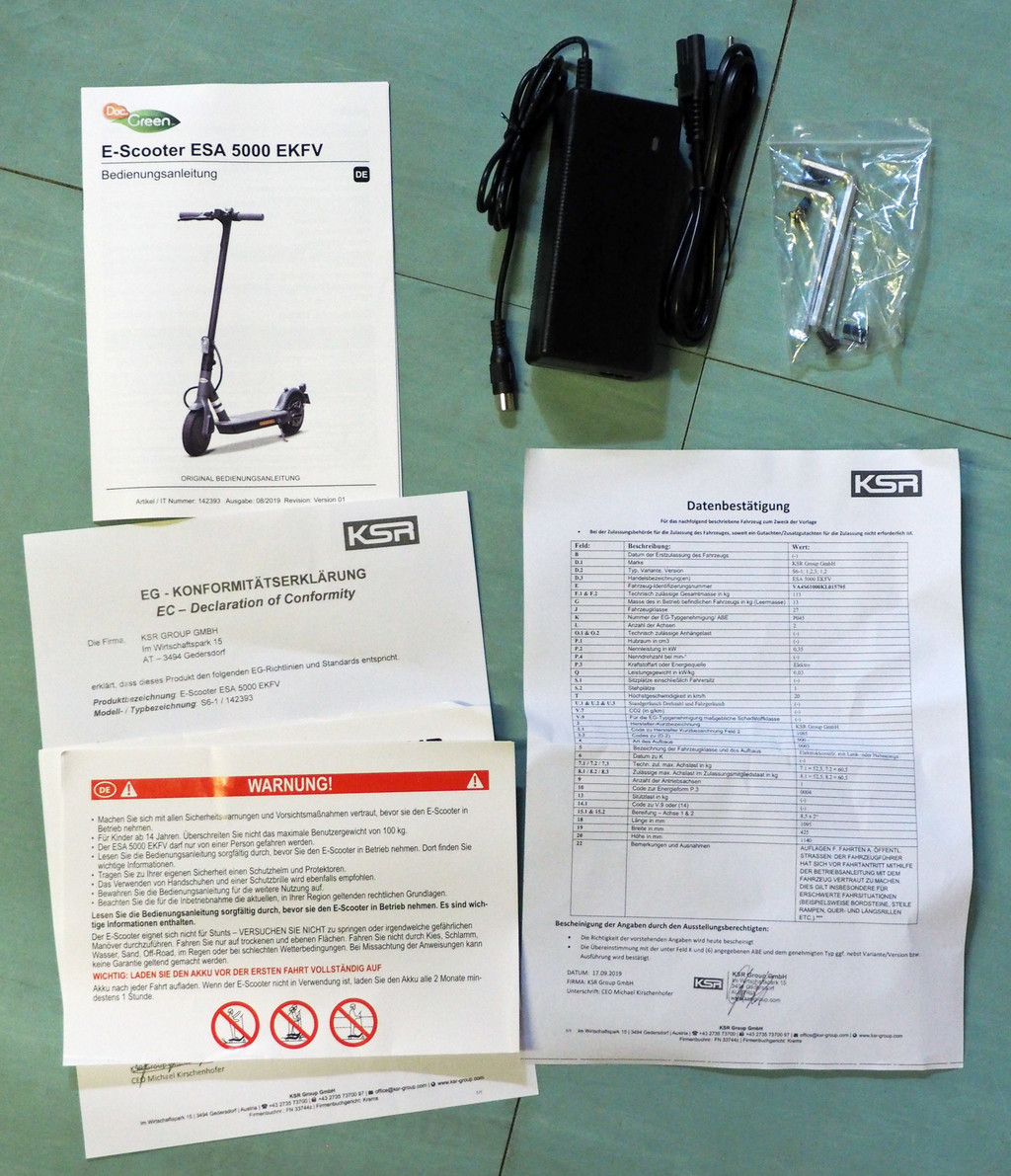
The latter is important because it corresponds to a "General Operating License" and the vehicle can only be insured on its presentation. Completely assembled, the scooter was standing in front of me in all its glory just five minutes later (Figure 4).
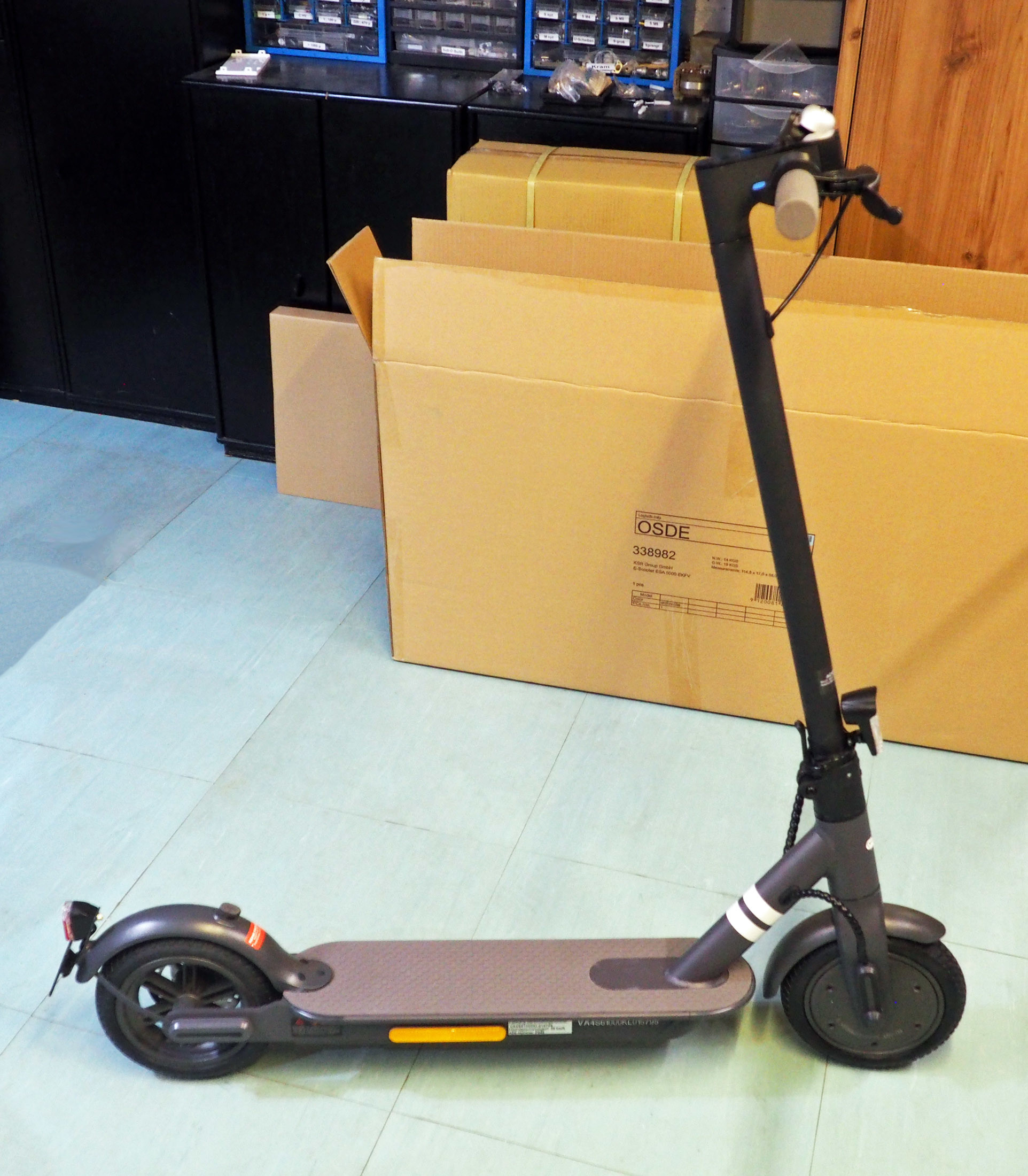
But before starting the scooter, I had to find out where to switch it on and what the LEDs etc. mean. According to the manual you press the black button on the handlebars to switch the scooter on. Then the very bright, two-digit display lights up with the correct speed of 00 km/h and the LEDs indicate the charge level of the battery. Figure 5 shows the handlebars in riding position. At this point my zest for action was abruptly slowed down because there wasn't much power in the battery, and the manual demands a first full charge. The red paddle on the left is the recuperation brake and the blue one on the right is a kind of thumb operated throttle. The handlebar grips are not rotatable. In the upper right you can see the brake lever for the rear disc brake.
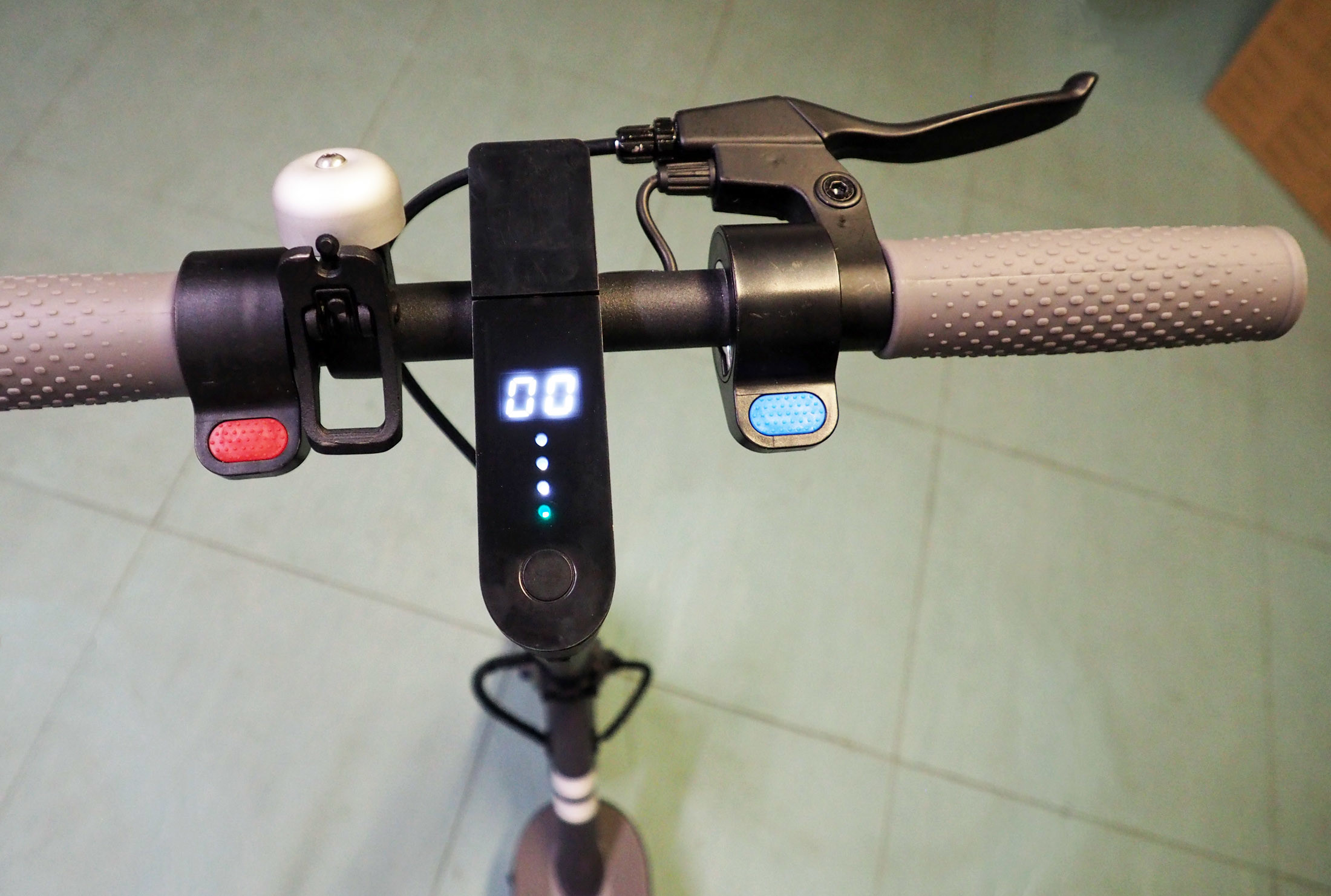
Five hours later the battery was full. The first test drive could have started now. Tried it out in the cellar: yes, it drives. Even then I noticed: there's not that much power, even if it was still in eco mode to be on the safe side. But before setting off, I wanted to know how well this electric scooter is designed.
A look at the frame shows that the aluminium tubes are neatly welded (Figure 6). The mechanism for locking the handlebars also looks very stable.
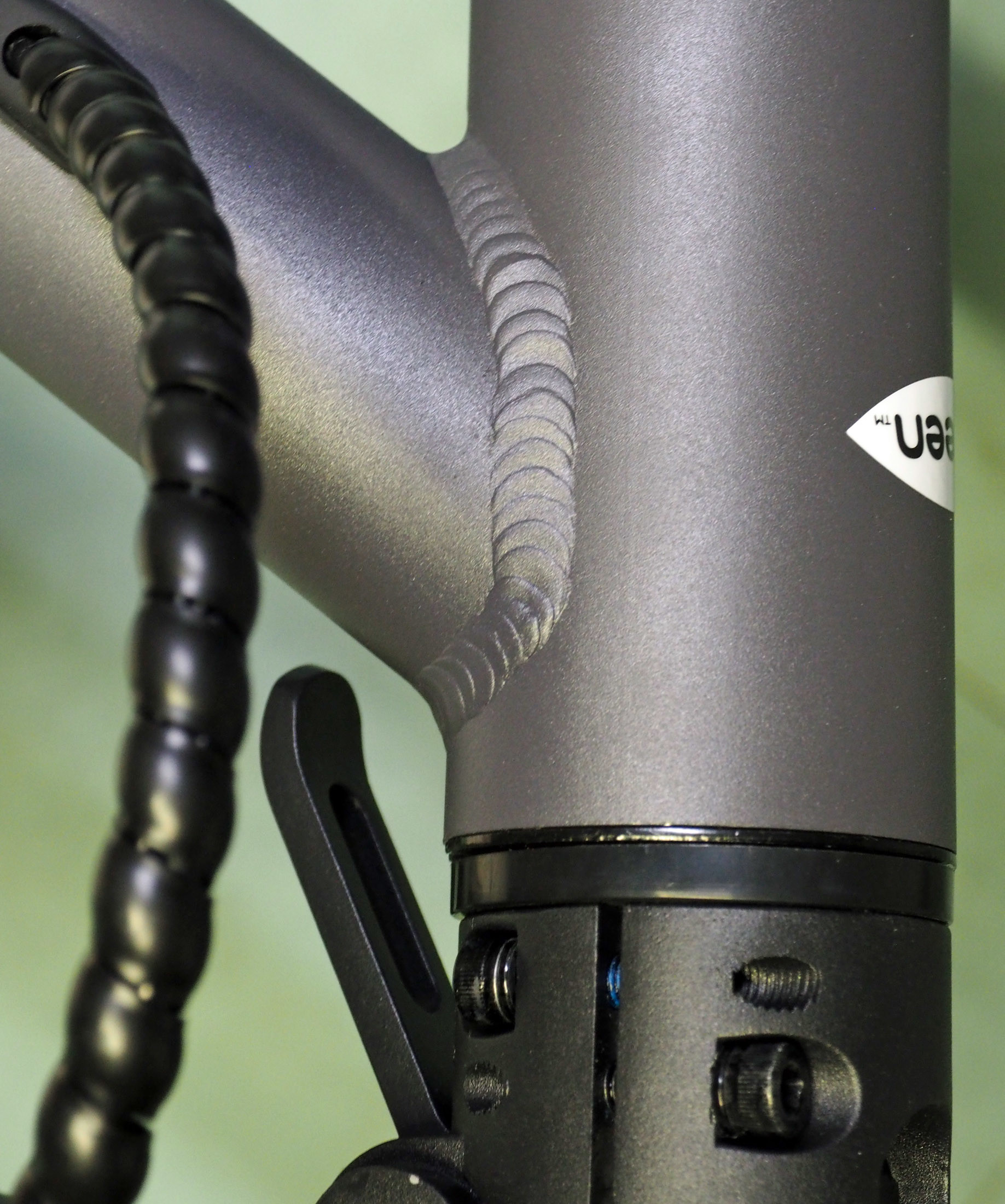
Figure 7 shows the front wheel. Lidl talks about "8.5" air chamber tyres (Honeycomb)" but I am not convinced. It reminds me more of normal solid tyres. In any case you don't have to fear any loss of pressure.
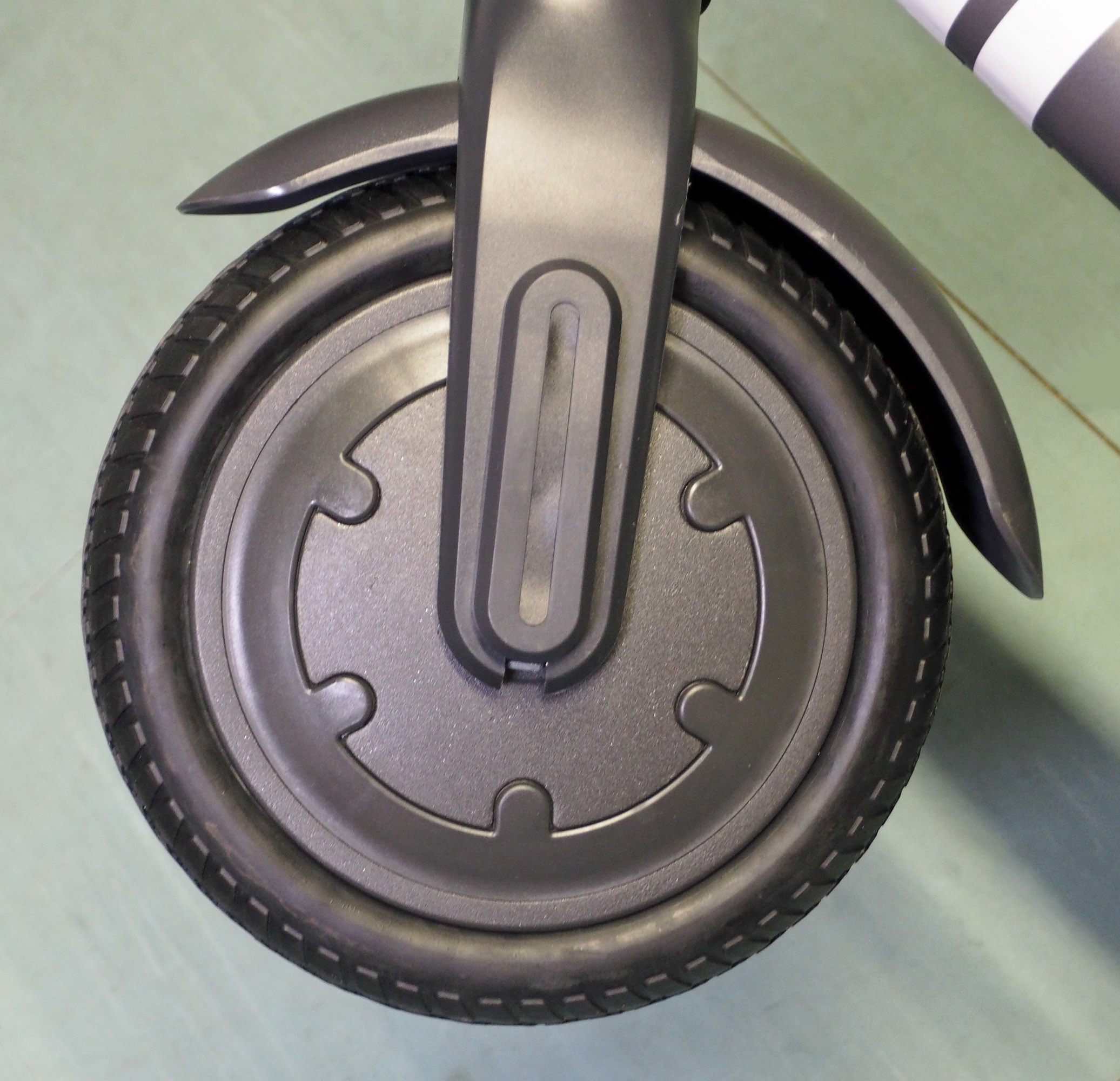
Figure 8 shows the rear wheel with the oversized, perforated brake disc, rear lighting and license plate holder. The grey rubber nipple at the top is used to lock the folded-down handlebars. So you can carry the scooter comfortably despite its weight of around 15 kg. You can find more details in the Features box.
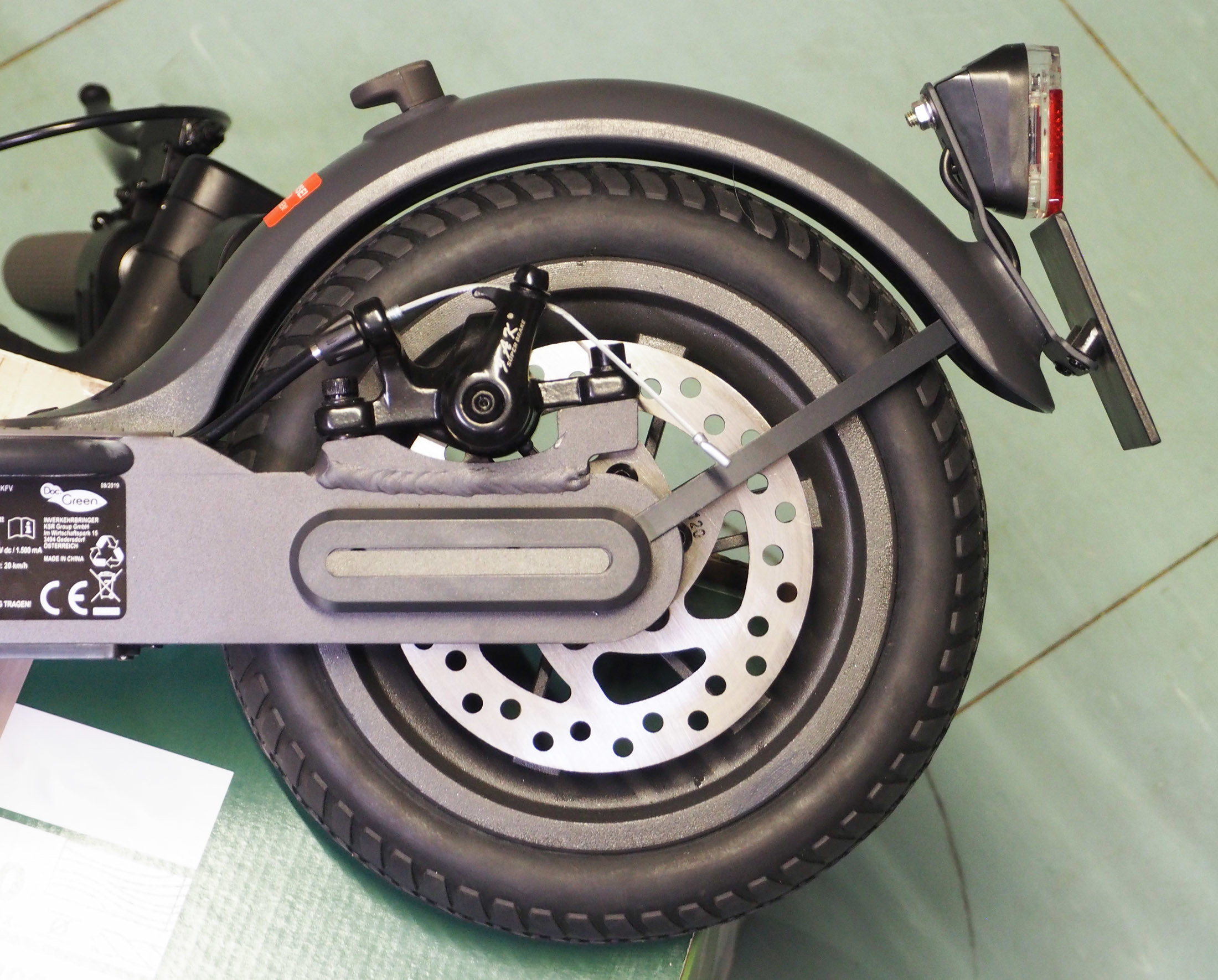
Inner life
As always, the innards are particularly interesting for electronics engineers. So the scooter had to be screwed open right away. That's easy, because there is only a thicker plastic cover at the bottom (Figure 9). Thirteen screws later you have it in your hand.

Figure 10 shows that it is simply sealed with a foam tape. No big problem, because eBay offers such aluminium covers for little money in different colours for the Xiaomi M365 (search for "Bottom Battery Cover Xiaomi M365") and they should fit. In general, there are a lot of matching accessories under the keyword "M365".
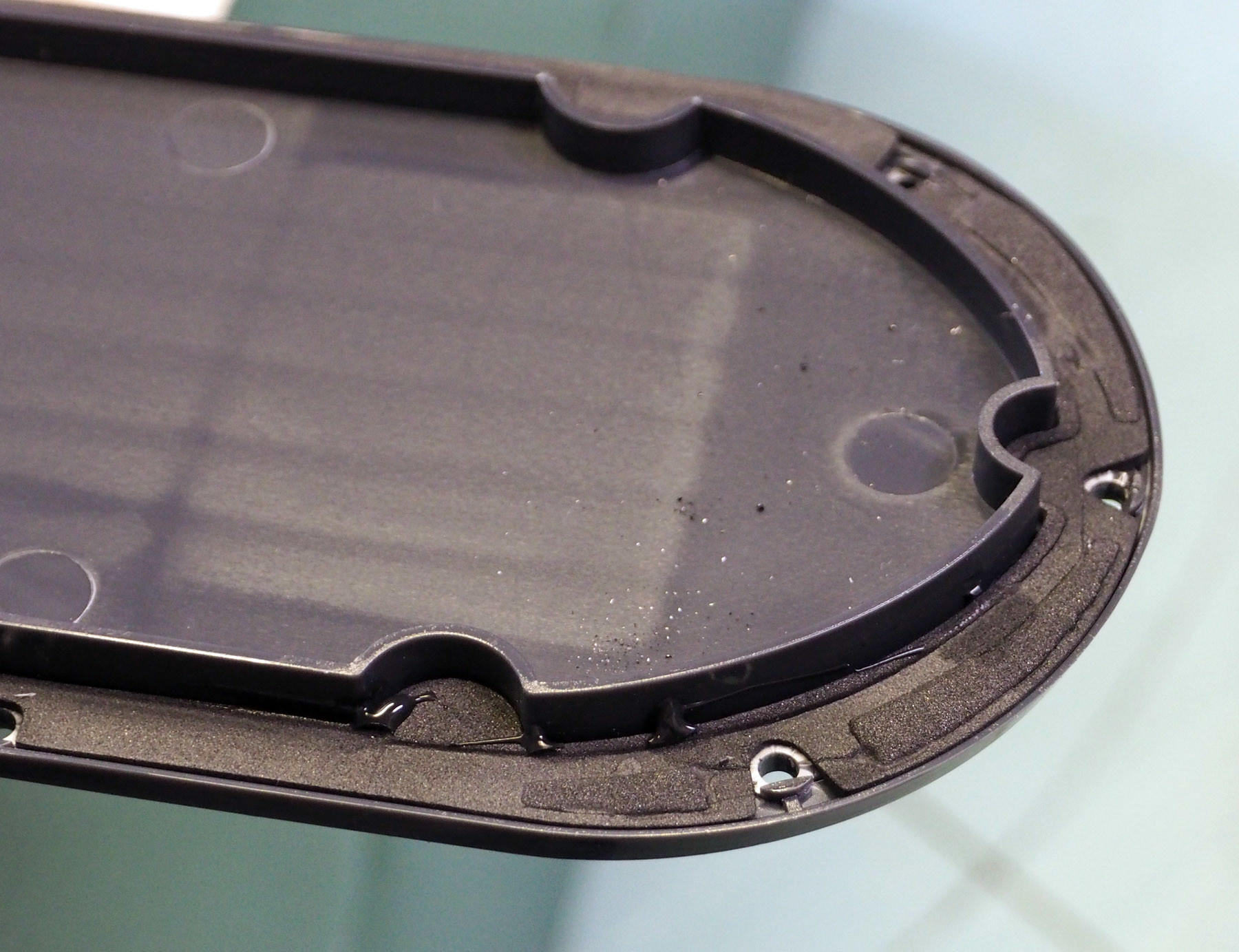
Figure 11 shows the most important thing: the battery. It is built from round cells (type 10s3p) and looks quite decent. The brochure information is also correct. The battery is screwed to the frame from below and is easy to replace if faulty.
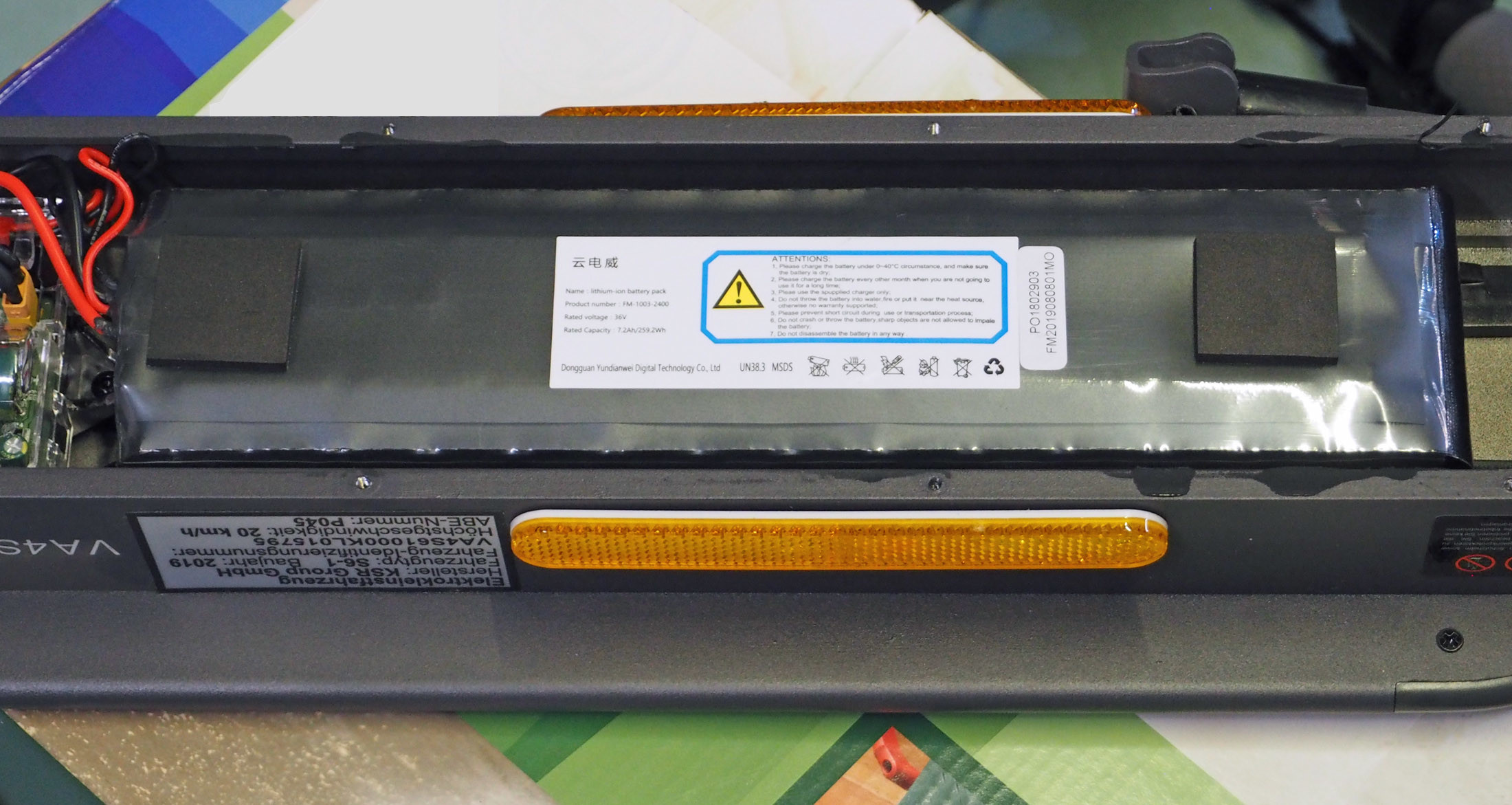
The second most important thing is the electronics: Figure 12 shows that it is extra protected from moisture by a transparent plastic case. The six MOSFETs for a three-phase bridge circuit are clearly visible. From this it is clear that it is an electronically controlled BLDC motor, which makes it efficient and durable.

Figure 13 shows the charging socket, which is protected with a rubber plug. Again the great welding seams impress.
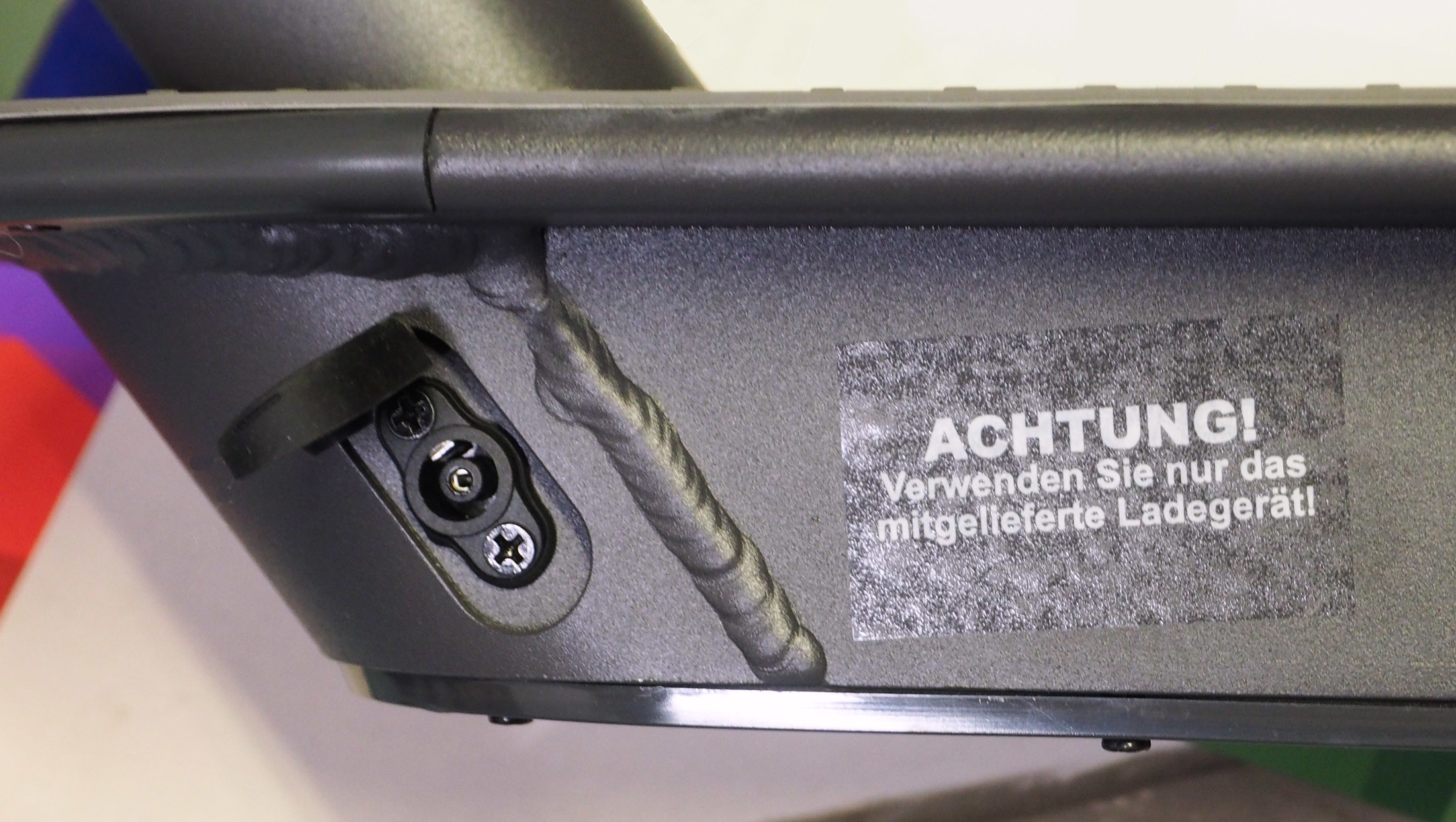
Test drive
After everything was reassembled, I went out into the street. In the YouTube video you can admire my first, still cautious driving attempts. At first I only dared to drive in eco mode, which goes up to 15 km/h. And rightly so!
To make the scooter accelerate, you must first push it to a speed of over 2 km/h. This is no problem, one push is enough. This little inconvenience has the advantage that the high power consumption when moving off is reduced and the batteries last longer. Here we go and the 15 km/h did not feel unsafe despite the small wheels. But then came the reversing, and as we all know, you have to brake for that. First of all: I didn't break anything...
Of course I tested the left red lever with the recuperation brake first. Unfortunately it has a rather digital behaviour and the scooter brakes abruptly and strongly. Since I was not prepared for this, I almost flew across the handlebars. So I accelerated again and then decelerated with the rear brake. The too you have hardly any control in the lever. The disc brake is much too violent for my taste. If there would be foliage, the rear wheel would be gone. So far, so hard.
There's hardly any feeling of acceleration in eco mode. I would have imagined 350 watts differently. But maybe the full power only comes in normal mode, I thought. So I stopped, pressed the black button twice to switch over and off I went. It may be that there is some measurable difference between the modes except the final speed, but I could hardly feel it. After all, the Lidl scooter runs its 20 km/h as promised. That should be enough.
Conclusion
In general I was positively surprised by the quality of the e-scooter. It is really neat and stable. The battery doesn't disappoint either and you can fully trust it to have the 22 km range - I haven't tried it though as I don't like pushing. The electronics also look good and the lighting is bright and sufficient. That a scooter like this can be made for this price amazes me.
I didn't like the acceleration so much though. That should be 350 W, really? There is no real electric feeling - except when recuperating. So to the biggest shortcoming: the brakes are just too violent. While the disc brake certainly gets a bit smoother over time, recuperation is simply too aggressive. Whoever designed this has only used a part of his mental potential.
All in all, I would come to a positive overall assessment despite the brakes taking some getting used to. The price/performance ratio is already very good. Nevertheless, I would strongly advise you to take a test drive if you want to buy such an e-scooter for yourself or your offspring.
A good friend of mine tried out if this scooter fits into the frunk (coinage from front and trunk) of his brand new Tesla Model X. Figure 14 proves that it does. Martin would like to drive around town on the scooter in case his Tesla takes a break at a charging station. A good idea and the scooter is certainly cheaper than a wing mirror of his new electric vehicle. But the Tesla is 12.4 times faster and offers 885 times more power.
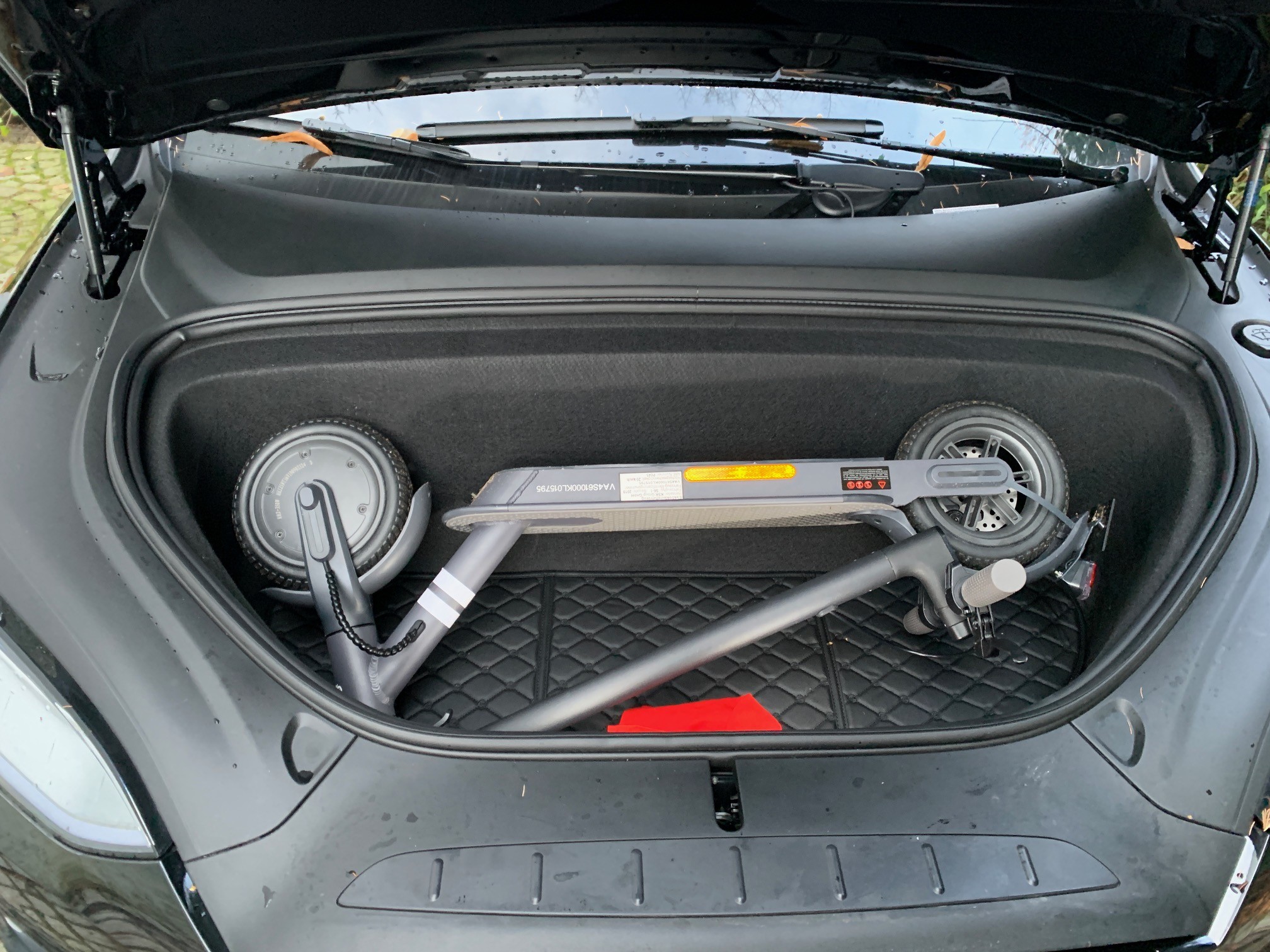
Want more great Elektor content like this?
Then take out an Elektor membership today and never miss an article, project, or tutorial.



Discussion (0 comments)